 |
|
|
- Hisaya Morishige, the Great Hiratsuka Air Raid and Houzenin -
Ryuko Matsushita, Chief Priest of Houzenin
March 10, 2010 |
[Japanese Page]
|
|
Last November, Hisaya Morishige, known as the doyen of the Japanese entertainment
world, passed away at the age of 99. Many paid tribute to the memory of
the great actor. One of them was Mikio Haruna, a journalist and professor
at the Graduate School of Languages and Cultures, Nagoya University. His
article, published in the November 20, 2009, issue of the Nikkan Gendai
tabloid, was very unusual.
"Morishige participated in Covert Operations at the U.S. Embassy"
was the title of Haruna's article. He wrote: "For a certain period
during the postwar years, Morishige was engaged in a secret task assigned
to him by the radio department of the U.S. Embassy in Tokyo." According
to the professor, the task was part of psychological operations conducted
by the National Security Council (NSC) to "make Japanese people like
the U.S." Haruna also argued that the secret operations proved very
successful and continued until 1971, with the participation of Morishige
and other prominent actors and actresses of the time, including Ayuro Miki,
Mariko Miyagi, Michiyo Yokoyama and Meiko Nakamura. In fact, a hidden purpose
of the post-war operations was deeply linked to the large-scale air raid
on Hiratsuka City in 1945.
The Great Hiratsuka Air Raid occurred less than a month before the end
of the war. From midnight of July 16, 1945 to the following day, Hiratsuka
was attacked by 138 B-29 bombers of the U.S. Air Force flying in formation.
The city was bombed so heavily that a resident of a neighboring town, who
lived in a house with a good view of the destroyed city, said later, "The
city was burning like anything. It was so bright outside that I could read
a newspaper late into the night." That night, 8,000 of the city's
10,419 houses were burned down and 343 people died. Houzenin, our temple,
also went up in flames and was completely destroyed.
 |
| B-29 Superfortress bombers dropping incendiary bombs. |
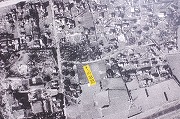 |
| Photo of Houzenin's neighborhood taken just after the air raid (by the
U.S. Air Force) |
| At that time, I was only one-and-a-half-years old. With me on her back,
my mother ran with my grandmother through furious fire for Oiso, a neighboring
town where our relatives lived. As my mother told me when I grew up, all
we could do that night was reach the bridge to Oiso, 700 meters away from
our temple. We spent a sleepless night under the bridge over the Hanamizu
River. Though it must have been an important target, the bridge just managed
to avoid being hit by a bomb and we survived; or the U.S. Air Force may
have left it as it was on purpose, in order to use it for their subsequent
landing operations. In those days, when going to sleep at night, my mother
used to place our temple's Kakocho (Buddhist death registers) wrapped in
a cloth at the head of her bed, so that she could carry it with her in
an emergency. She ascribes our survival in the rain of bombs to the Honzon-sama
(main deity) of Houzenin, the Kakocho and our ancestors. The devastation
caused by the air raid was so complete that it was only natural for her
to think this way. I have no idea what was registered in my memory, but
for some reason, I still do not like the United States. Perhaps etched
deep in my memory is the sight of my mother with a baby on her back running
frantically for a way out of the red tongues of flame. |
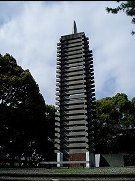 |
| Hiratsuka city war dead memorial |
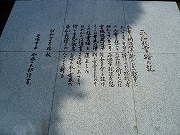 |
| Peace memorial inscription |
The U.S. Air Force had two bombing strategies: carpet and screw attacks.
In the case of Hiratsuka, the latter was used. This is how a screw attack
is made. First, a bomb is dropped in the center of the target area. Then,
bombs are dropped one after another in a clockwise spiral. Curtains of
fire are created and the people surrounded are likely to die from lack
of oxygen and intense heat. Such indiscriminate killing of civilians apparently
violates the Geneva Convention. The bombardment Hiratsuka suffered is called
the "Great Air Raid" because more bombs were dropped (447,716
incendiaries, 1,173 tons in total) than in the Tokyo Air Raid of March
10, 1945 (380,000 incendiaries). According to the Japanese Edition of Wikipedia,
the air raid on Hiratsuka is second only to that on Hachioji (a city in
southwestern Tokyo) in terms of the amount of bombs dropped per unit area.
Considering the fact that 8.2 incendiaries were dropped per resident, the
death toll was notably low. For one thing, there were quite a few evacuees
from Tokyo, who had experienced air raids in the capital and passed on
their "survival know-how" to Hiratsuka residents. In addition,
Hiratsuka was then a farming area and many fields separated the houses.
For these reasons, not as many people died in the fire as in Tokyo, where
some 100,000 people died on March 10 alone.
On the morning after the horrible bombing, so worried about us, our relatives
in Oiso came to our temple to find that it had been completely burned down.
They cried out my mother's name at the top of their voices, but in vain.
Thinking that we were all burned to death, they returned home with their
hearts in their boots. They told me the story when I was old enough to
understand things.
Years later, I entered nearby Fujimi Elementary School. Yokohama Rubber,
Nissan Shatai, Sankyo and other companies built their factories on the
burned flat land and many workers moved in with their families from around
the country. When I was a fifth or sixth grader, our elementary school
was so crowded that some pupils (including me) transferred to a branch
school. The makeshift school was in a building that was once a boarding
house for workers of the Hiratsuka Naval Ammunitions Arsenal. (During the
postwar years of recovery, there were no other buildings available in the
city.) On the wall of our classroom, there was a message in black ink:
"Meet me at Yasukuni Shrine (as the war dead)," perhaps written
by a young soldier who was going to war. During recess, we often picked
up bullets. Come to think of it, we shanty dwellers in the burned ruins
lived just the way war orphans in Baghdad do now.
From back then, there was a deeply held belief among Hiratsuka residents,
which still remains. It claims that U.S. forces bombed Hiratsuka in order
to destroy the Hiratsuka Naval Ammunitions Arsenal. People born in my generation
have been told about the story ever since we were young children, and I
think most of the residents still accept it. My friends and I believed
it all the more because we went to the arsenal-turned school every day.
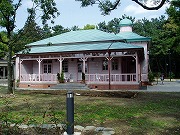 |
| Officers' Lounge, Hiratsuka Naval Ammunitions Arsenal memorial structure |
The Hiratsuka Naval Ammunitions Arsenal occupies an important place in
Japanese military history. As the nation's first gunpowder plant, it was
jointly built in 1905 by three British companies: Armstrong Whitworth,
Novel and Chilworth. The explosives produced here were used in the Russo-Japanese
War (1904-1905). Ironically enough, only a few decades after its inauguration
through the efforts of British architects and supervisors hired for the
project, the arsenal was bombed and destroyed by the Allies, including
the United States and Britain. And the bombing thrust the citizens into
the deadly throes. Now there is a factory on the site.
The U.S. freedom of information act is said to be a recent big headache
for the Japanese Foreign Ministry. Based on the act, U.S. diplomatic documents
are disclosed after a certain period of time, regardless of the contents.
They may reveal secret agreements with the United States and behind-the-scenes
maneuvers of the Japanese Foreign Ministry playing dumb with the public,
including deals regarding the transport of nuclear weapons into Japan and
the reversion of Okinawa to Japan. This reminds me of the well-known joke
of a popular manzai stand-up comedian couple: "If it cannot be found,
let's keep it a secret." Despite the ministry's doga-chaka attempts
to keep the maneuvers secret from the public, the U.S. disclosure act gave
the whole show away. (Doga-chaka is a cliche used in a famous rakugo comic
story to explain the way the general manager of a store doctors the accounts
so that he can keep his fingers in the till.)
Materials covering the Great Hiratsuka Air Raid, were also disclosed
by the National Archives and Records Administration (NARA) 50 years after
the tragedy. An acquaintance of mine visited NARA to browse the materials
and returned with some surprising news. Despite a widely accepted belief,
the U.S. Air Force didn't care at all if the ammunitions arsenal was destroyed!
Near the end of the war, the crew of a Grumman spy plane reported that,
for lack of materials, plant workers did not manufacture explosives but
grew potatoes to survive. An arsenal that produces potatoes-what a joke!
For young readers' information, Grumman Aircraft Engineering's fighter
aircraft were American counterparts of the "Zero" fighter. In
Japan, U.S. fighters were collectively called "Grumman".
Harking back to his childhood, a man about ten years older than me often
said proudly that he had been pursued and shot at by a Grumman fighter
while at the beach and in the schoolyard. He said, "The guy at the
controls of the Grumman flew out of sight, sneering at me." (Many
children were killed miserably in such a manner.) In other words, Grumman
aircraft flew to Japan very often for aerial surveillance. They had already
known that the arsenal was producing potatoes instead of explosives.
Now I remember that some elderly people said that on the morning of the
day the war ended, August 15, 1945, there were countless U.S. warships
off the coast of Hiratsuka. How do the facts relate to each other? The
disclosed U.S. documents answer the question.
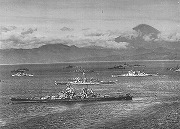 |
| US Marine warships in Shonan. |
According to the documents disclosed by NARA, there were four reasons
behind the Hiratsuka air raid:
| - |
Hiratsuka was intended as the beachhead for the landing operations. |
| - |
Learning the bitter lesson of the ground battle of Okinawa that killed
many U.S. soldiers, the U.S. forces planned to clear all the buildings
from the beachhead so as not to provide enemy snipers with a place to hide. |
| - |
Any Japanese survivors were to be killed with sarin nerve gas. |
| - |
After landing on Hiratsuka, soldiers were to make a beeline to the north
as far as Hachioji, before turning right and reaching central Tokyo along
the Chuo Line railway. (The plan explains the connection between air raids
on Hiratsuka and Hachioji. In the early hours of August 2, 1945, Hachioji
was attacked by 170 B-29 bombers that dropped 670,000 incendiaries, which
burned 80% of the urban area and killed 450 residents.) |
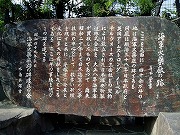 |
| Naval Ammunitions Arsenal memorial tablet |
Now we know that Hiratsuka was bombed to establish a beachhead, not to
destroy the ammunitions arsenal. So why did Hiratsuka citizens believe,
for decades, that their city was attacked because of the potato-producing
plant?
Among the General Headquarters' occupation policies was the War Guilt
Information Program (WGIP), developed to convince the Japanese people that
the responsibility for the war lay with them. The program was led by Earnest
Hilgard (1904 - 2001), a professor of Stanford University, and Milton Erickson
(1901 - ). I am not sure if you know that, but the two are the 20th century's
leading experts in the field of hypnosis and brainwashing. These experts
delivered a grand educational program to brainwash the people of Japan
into believing that they themselves are responsible for and guilty of the
whole tragedy of the war (including the atomic bombing of Hiroshima and
Nagasaki). Jun Eto (1932 - 1999), a critic and professor of Keio University,
compiled his research reports into a book after a lifetime of work. The
cover of the book "Closed Language Space: Censorship by Occupation
Forces and Postwar Japan" (Bunshun Bunko paperback published by Bungeishunju
Ltd.) says:
"Japan lost World War II and was occupied by the U.S. forces. The
victor carefully prepared for and enforced censorship in the defeated nation,
in order to destroy Japanese ideology and culture completely. As a result
of the censorship program, 'a loss of self' among the Japanese public led
to self-propagation of a new taboo."
As far as the Great Hiratsuka Air Raid is concerned, WGIP was intended
to convince the citizens that they were responsible for the bombing of
their city because it would not have been destroyed if they had not built
the gunpowder plant there. In this way, the United States made an attempt
to draw the citizens' attention away from the canceled invasion operations
including the sarin attack plan. I think the trick turned out to be a great
success, for most of them have believed for 60 years that the city was
attacked because of the plant. The secret operations by the U.S. Embassy
with the help of Hisaya Morishige, which I mentioned at the beginning of
this report, were part of the grand project of Japanese occupation related
to WGIP. Now most Japanese people seem to like the former foe very much,
and I must say that WGIP was a huge success.
References
1. Aerial photo of Houzenin's neighborhood taken just after the Great Hiratsuka
Air Raid (original stored at the National Archives and Records Administration)
2. Officers' Lounge, Hiratsuka Naval Ammunitions Arsenal memorial structure
3. Hiratsuka city peace memorial dedicated to those who died in the war
including air raid victims
4. US Marine warships in Shonan (original stored at the National Archives and Records Administration)
5. Hiratsuka Naval Ammunitions Arsenal memorial inscription
6. Mainland invasion campaign and sarin gas attack plan
In April 1945, Franklin Roosevelt died of a stroke and Harry Truman took
office. The 33rd U.S. President gave approval to "Operation Downfall",
the Japanese mainland invasion campaign, which was canceled because of
Japan's surrender earlier than expected. Hideji Okina, a freelance writer,
writes about their extraordinary plan in his article "U.S. Air Forces
Planned to Use Sarin Gas in Invasion of Japan", published in the August
17 and 24, 2006 combined issue of the Shukan Shincho weekly magazine. The
campaign consisted of two stages to secure Japan's unconditional surrender:
Operation Olympic, the invasion of southern Kyushu (Japan's third largest
island) with 820,000 soldiers, and Operation Coronet, the invasion of the
Kanto Plain containing the capital, with a million soldiers. The writer
argues that the U.S. forces, intimidated by Japan's desperate resistance
during the ground battle in Okinawa, decided to make elaborate preparations
for landing: saturation air raids, intensive naval bombardment and extermination
with sarin gas. The U.S. Navy shipped almost 60,000 poison gas bombs to
the front-poison gas bombs were supposed to account for 20% of all the
bombs for the campaign. The estimated death toll from Operation Olympic
was one million and that from Operation Coronet was several million. The
Great Hiratsuka Air Raid was nothing but a sign of the beginning of Operation
Coronet for the invasion of the Kanto area.
The local residents' story about an enormous number of U.S. warships
seen on the morning of August 15, 1945 fits the explanation of Operation
Coronet. Is it a miracle or a prank that I, born in Hiratsuka in 1944,
survived the deadly air raid, escaped the poisonous attack and write this
report now?
- Afterword -
During the war, many Houzenin officials were killed and in the end, the
entire premises were burned to ashes just before the war ended. The previous
chief priest suffered great hardships to reconstruct the temple. I think
these are honest questions Japanese people have in their minds: Why did
they have to face such reckless deeds? Why did many lives have to be lost
so miserably? And I also wonder why all the halls and pagodas of Houzenin,
including valuable cultural treasures, had to be destroyed. As one of the
survivors of the horrible air raid, I put together my long pondered questions
into this report.
As far as I feel at this time, a remote cause of this tragedy seems to
lie in the way political power was shifted during the Meiji Restoration
(in the late 19th century) as well as the character of those who grabbed
power.
|
|
|
|
|